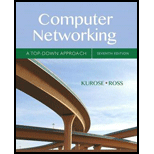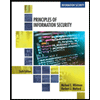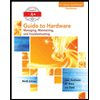
Let’s review some of the terminology used in this textbook. Recall that the name of a transport-layer packet is segment and that the name of a link-layer packet is frame. What is the name of a network-layer packet? Recall that both routers and link-layer switches are called packet switches. What is the fundamental difference between a router and link-layer switch?
Link Layer:
Link layer is the aggregation of procedures and protocols used in a link to share the data between the nodes. It includes mainly three functions namely, detection of transmission errors, regulation of data flow and provides well-structured interface.
Explanation of Solution
Description of network layer packet:
- Network layer is provides the path in which the data packets are transferred from the source to the destination.
- It also helps in converting the logical or Internet Protocol (IP) address to physical or Media Access Control (MAC) address.
- The packet related to network layer can be termed as datagram.
Differences between router and link layer switch:
| Router | Link layer switch |
|
The router process in the internet protocol is done by network layer, link layer and physical layer. In latest routers, transport layer is also included. |
The link layer switch process is done using data link layer and physical layer. |
| A router transmits the data packet using IP layer address. | A link layer transmits the data frames using MAC layer address. |
| In router, the data in transmitted in the form of packets or data packets. | In link layer switch, the data is transmitted in the form of frames or data frames. |
| It is used in Local Area Network (LAN), Wide Area Network (WAN) and Metropolitan Area Network (MAN). | It is used in LANs only. |
| In this, the data is transmitted in full duplex mode. | In this, the data is transmitted in both full duplex and half duplex modes. |
Want to see more full solutions like this?
Chapter 4 Solutions
Computer Networking: A Top-Down Approach (7th Edition)
Additional Engineering Textbook Solutions
Starting Out With Visual Basic (8th Edition)
Thermodynamics: An Engineering Approach
Electric Circuits. (11th Edition)
Thinking Like an Engineer: An Active Learning Approach (4th Edition)
Java: An Introduction to Problem Solving and Programming (8th Edition)
HEAT+MASS TRANSFER:FUND.+APPL.
- Could you help me to know features of the following concepts: - defragmenting. - dynamic disk. - hardware RAIDarrow_forwardwhat is a feature in the Windows Server Security Compliance Toolkit, thank you.arrow_forwardYou will write a program that allows the user to keep track of college locations and details about each location. To begin you will create a College python class that keeps track of the csollege's unique id number, name, address, phone number, maximum students, and average tuition cost. Once you have built the College class, you will write a program that stores College objects in a dictionary while using the College's unique id number as the key. The program should display a menu in this order that lets the user: 1) Add a new College 2) Look up a College 4) Delete an existing College 5) Change an existing College's name, address, phone number, maximum guests, and average tuition cost. 6) Exit the programarrow_forward
- Show all the workarrow_forwardShow all the workarrow_forward[5 marks] Give a recursive definition for the language anb2n where n = 1, 2, 3, ... over the alphabet Ó={a, b}. 2) [12 marks] Consider the following languages over the alphabet ={a ,b}, (i) The language of all words that begin and end an a (ii) The language where every a in a word is immediately followed by at least one b. (a) Express each as a Regular Expression (b) Draw an FA for each language (c) For Language (i), draw a TG using at most 3 states (d) For Language (ii), construct a CFG.arrow_forward
- Question 1 Generate a random sample of standard lognormal data (rlnorm()) for sample size n = 100. Construct histogram estimates of density for this sample using Sturges’ Rule, Scott’s Normal Reference Rule, and the FD Rule. Question 2 Construct a frequency polygon density estimate for the sample in Question 1, using bin width determined by Sturges’ Rule.arrow_forwardGenerate a random sample of standard lognormal data (rlnorm()) for sample size n = 100. Construct histogram estimates of density for this sample using Sturges’ Rule, Scott’s Normal Reference Rule, and the FD Rule.arrow_forwardCan I get help with this case please, thank youarrow_forward
 Principles of Information Security (MindTap Cours...Computer ScienceISBN:9781337102063Author:Michael E. Whitman, Herbert J. MattordPublisher:Cengage Learning
Principles of Information Security (MindTap Cours...Computer ScienceISBN:9781337102063Author:Michael E. Whitman, Herbert J. MattordPublisher:Cengage Learning Systems ArchitectureComputer ScienceISBN:9781305080195Author:Stephen D. BurdPublisher:Cengage Learning
Systems ArchitectureComputer ScienceISBN:9781305080195Author:Stephen D. BurdPublisher:Cengage Learning A+ Guide to Hardware (Standalone Book) (MindTap C...Computer ScienceISBN:9781305266452Author:Jean AndrewsPublisher:Cengage Learning
A+ Guide to Hardware (Standalone Book) (MindTap C...Computer ScienceISBN:9781305266452Author:Jean AndrewsPublisher:Cengage Learning A+ Guide To It Technical SupportComputer ScienceISBN:9780357108291Author:ANDREWS, Jean.Publisher:Cengage,
A+ Guide To It Technical SupportComputer ScienceISBN:9780357108291Author:ANDREWS, Jean.Publisher:Cengage, Principles of Information Systems (MindTap Course...Computer ScienceISBN:9781285867168Author:Ralph Stair, George ReynoldsPublisher:Cengage Learning
Principles of Information Systems (MindTap Course...Computer ScienceISBN:9781285867168Author:Ralph Stair, George ReynoldsPublisher:Cengage Learning Operations Research : Applications and AlgorithmsComputer ScienceISBN:9780534380588Author:Wayne L. WinstonPublisher:Brooks Cole
Operations Research : Applications and AlgorithmsComputer ScienceISBN:9780534380588Author:Wayne L. WinstonPublisher:Brooks Cole





